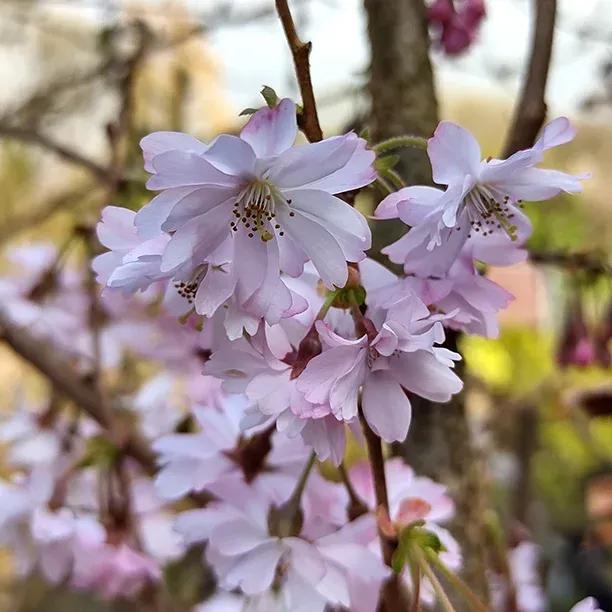Winter Flowering Cherry Large Trees

The details
- Winter flowering cherry.
- Narrow, slender tree. Casts light shade.
- White blossom.
- Max. Height: 10m
Recommended extras
Description
Prunus Autumnalis: Bareroot Winter Flowering Cherry Trees in Standard Sizes
Prunus subhirtella Autumnalis is an Autumn-Winter flowering cherry tree with dark pink buds that open into mostly white blossom. It blooms on bare wood during mild spells from late October to February. The flowers are sometimes followed by very bitter small fruit, which are loved by birds. The leaves are bronze in spring, turning green and then ruddy-gold in autumn. A very pretty tree that casts light shade and can be grown in the smallest garden.
It can reach a height of about 7 metres.
Browse our range of cherry blossom trees or all our garden trees.
Delivery season: Cherry blossom trees are delivered bareroot during late autumn and winter, approximately November-March inclusive.
Choosing a size: Small trees are cheaper, easier to handle and more forgiving of less than ideal aftercare, so they are best for a big planting project. If instant impact is your priority, or if you are only buying a few plants for use in a place where it is convenient to water them well in their first year, then you may as well use bigger ones. All our bareroot trees are measured by their height in centimetres above the ground (the roots aren't measured).
Features:
- Height: To 7m
- Soil: Any decently well drained
- Use: Specimen, small gardens
- Colour: Pink buds, mostly white blossom in October-February
- Bareroot delivery only: November-March
Growing Prunus Autumnalis
It will grow on most well drained soils, preferably rich ones, and although it is a hardy tree, we recommend planting it in sheltered, sunny places, where it will flower best.
Planting Instructions
Notes on planting Prunus subhirtella Autumnalis trees:
Prunus subhirtella Autumnalis prefer fertile, moist soil with good drainage. They like heavy clay, as long as the site doesn't become waterlogged in winter. They are good to grow on chalky soil.
Although they are tolerant of shade, we really recommend them for full sun. Cherry trees in the shade tend to become spindly and won't flower very well.
We don't recommend them for exposed, windy sites, where they will be blown out of shape by the wind.
Although your trees are hardy, late spring frosts can ruin their flower display. Avoid planting cherry blossom trees in frost pockets or North facing sites in colder areas.
Prepare your site before planting:
It is good to dig over the site where you plant a tree several months in advance. Kill the weeds first: for tough weeds like nettles, brambles and ground elder, you will usually need a weed-killer to get rid of them. When you dig the soil over, remove stones and other rubbish and mix in well rotted compost or manure down to the depth of about 2 spades.
Watch our video on how to plant a tree for full instructions.
Remember to water establishing trees during dry weather for at least a year after planting.
Tree Planting accessories:
Prepare your site for planting by killing the weeds and grass.
You can buy a tree planting pack with a wooden stake & rubber tie to support the tree and a mulch mat with pegs to protect the soil around the base of your tree from weeds and drying out.
We suggest that you use mycorrhizal "friendly fungi" on the roots of all newly planted large trees: if your soil quality is poor, we strongly recommend it.
You can also improve your soil with bonemeal organic fertiliser.
Did You Know?
Introduced to Europe at the turn of the 20th century, the first tree came to Britain in 1894. It won RHS Awards for displays of its cut flowers. It is important for flower arrangers as it blooms in winter.
Standard trees are measured by their girth in centimetres 1 metre above ground level: their trunk's waist measurement. Unlike sapling trees and hedge plants, standards aren't measured by their height, which will vary quite a bit both between and within species.
So, a 6/8cm standard tree has a trunk with a circumference of 6-8cm and an 8/10 standard has a trunk 8-10cm around. This measurement makes no difference to the tree's final height.
On average, standard trees are 2-3.5 metres tall when they arrive, but we cannot tell you precisely how tall your trees will be before we deliver them.



 2.webp)
 3.webp)